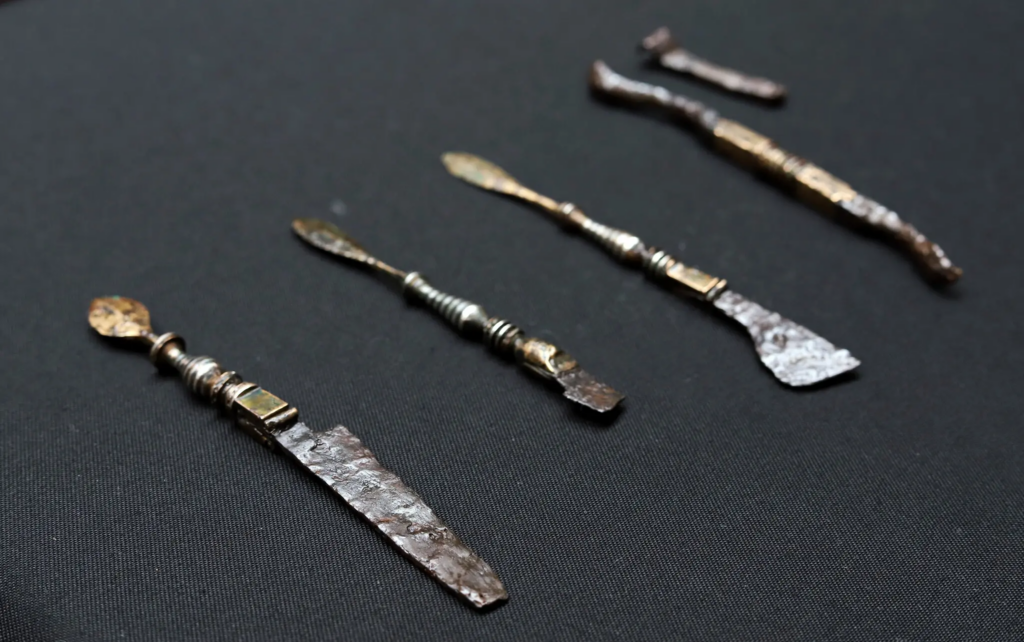The constant discovery of past technology undoubtedly changes our perception of how different advancements were made. Although it is true that today’s doctors have developed new techniques and methods, the doctors of the past, specifically Roman doctors, used many of the same medical tools that are currently used.

In 2022, archaeologists discovered the 2,000-year-old remains of a Roman doctor near Jászberény, Hungary, and alongside the body was a collection of medical instruments including: “a forceps, for pulling teeth; a curet, for mixing, measuring and applying medicaments, and three copper-alloy scalpels fitted with detachable steel blades and inlaid with silver in a Roman style” (Lidz, 2023). People created products with metal alloys because they were discovered to be harder and tougher. Additionally, copper has antimicrobial properties, and in a time where hygiene was not at the same standards as it currently is, it was important to limit the chance of infection as much as possible. However, the tools were probably made without this intention. Egyptians first mentioned the use of antimicrobial effects, and they used it to sanitize drinking water and to treat chest wounds.

The detail and material of these instruments indicated that the doctor was high-ranking and traveled to this area to perform his duties. Jászberény was part of a region outside of the Roman Empire and had a lot of conflicts. It was odd that a well-equipped medical professional would be there unless they came to the aid of a prestigious figure. Doctors were very rare according to Dr. Samu, research fellow at ELTE and member of the team on the dig, as, “Studying medicine was only possible, at the time, in a large urban center of the empire” (Lidz, 2023). Limiting the practice to a certain part of the empire, made medical work a very important occupation. Although this was not the first medical kit to be discovered, it was a rare find. Also, the limited amount of education offered, created many inexperienced medical professionals. Building a reputation in the empire would be important, indicating why this body that was discovered had such well-made instruments. Firsthand medical experience could also be found on the battlefield adding another possibility as to why the body could be found in this region.
The grave was purposefully chosen, and the doctor was most likely buried with his instruments as a sign of respect. However, as with all discoveries, it is not the only possibility and others must be considered.
Additional Information
How medical instruments were used – http://exhibits.hsl.virginia.edu/romansurgical/
More uses of Roman medicine – https://www.history.com/news/ancient-roman-medicine-galen
References
Arendsen, Linda P, Ranee Thakar, and Abdul H Sultan. 2019. “The Use of Copper as an Antimicrobial Agent in Health Care, Including Obstetrics and Gynecology.” Clinical Microbiology Reviews. U.S. National Library of Medicine. August 14, 2019. https://www.ncbi.nlm.nih.gov/pmc/articles/PMC6730497/.
Lidz, Franz. 2023. “Scalpel, Forceps, Bone Drill: Modern Medicine in Ancient Rome.” The New York Times. The New York Times. June 13, 2023. https://www.nytimes.com/2023/06/13/science/archaeology-ancient-rome-medicine.html.
Renfrew, Colin, and Paul Bahn. 2018. Archaeology Essentials: Theories, Methods, and Practice. Fourth edition. Thames & Hudson.

“The detail and material of these instruments indicated that the doctor was high-ranking and traveled to this area to perform his duties.” — What were some traits that implied the doctor’s social status, and, if we were to refer this hierarchical structure to the medical sphere of the present day, as well as the systemic violence that both hinders and is reified by its operations, what new insights might this blog post offer?